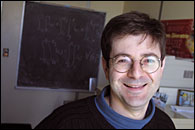Numbers theorist nabs Steacie
Sometimes two seemingly unrelated things yield surprising connections.
 Mathematics and statistics professor Henri Darmon
Mathematics and statistics professor Henri DarmonPHOTO: Owen Egan |
|
Like elliptic curves and modular forms -- or a 340-year-old mathematical puzzle and online shopping. Just ask mathematics and statistics professor Henri Darmon.
According to the Natural Sciences and Engineering Research Council, Darmon's work on elliptic curves has "gained him recognition as one of the world's leading young number theorists."
It has also earned Darmon NSERC's Steacie Memorial Fellowship, a $90,000 prize awarded for outstanding original research and one of the country's most prestigious prizes for scientists and engineers. Six were awarded to top professors across Canada this year.
As a number theorist, Darmon searches for hidden patterns and relationships among numbers. His studies involve mathematical formulas discovered in the late 19th century. Specifically, his interests lie in modular functions (as opposed to "naturally occurring" trigonometric functions like cosine and sine) which, he says, "take on values which are surprisingly structured."
Of these structures, Darmon is most interested in elliptic curves arising from computations involving the arc length of an ellipse. A few years ago, elliptic curves played a crucial role in cracking one of math's oldest mysteries: Fermat's Last Theorem.
When amateur number theorist Pierre de Fermat died in 1665, he left behind a deceptively simple notation that would challenge some of the best minds in mathematics for centuries. The equation xn + yn = zn has no solution for non-zero integers x, y and z if n is an integer greater than 2.
It wasn't until 1994, when Princeton professor Andrew Wiles proved a special case of what is known as the Shimura-Taniyama conjecture, a conjecture that dealt with the fundamentals of elliptic curves, that the Fermat enigma was finally cracked.
Darmon, who was working at Princeton at the time and supplied some of the groundwork for Wiles's breakthrough, was struck by the resultant "deep connection between two objects that are completely unrelated: one is elliptic curves, and the other is modular forms."
This connection is heady stuff for theorists -- let alone for the mathematical layperson -- but Darmon says his work on this front also has concrete applications in that most unifying of common denominators: shopping.
"Number theory is of mainly theoretical interest," he admits, "but the structures we explore, sooner or later, are brought to practical uses. Elliptic curves, for example, are important objects in cryptography. Many of the algorithms we rely on for the secure transmission of information on the Web -- for example, when we shop on the Internet and send a credit card number -- are based on number theoretic objects like elliptic curves.
"When we ask these very difficult questions, which take hundreds of years to be solved, in the course of trying to solve them we're led to introduce mathematical objects that can be used in day-to-day applications."
By basically paying two years' worth of an academic's salary, the Steacie Fellowship frees recipients from administrative and teaching duties, allowing them to concentrate full-time on research.
For Darmon, the prize will allow him to further immerse himself in Montreal's vibrant mathematical research community.
Darmon is currently a director with the Centre Inter-universitaire en Calcul Mathé-matique Algébrique, as well as a member of the Centre de Recherches Mathématiques, and he says the math community has "really expanded dramatically" since he began teaching at McGill in 1994.
"It's been really exciting to see the development of mathematics in the city," he says, "not just at McGill, but also at the other three universities. It provides a lot of material support for my own research, and the resources allow me to bring in a lot of very good young people both as post-doctoral fellows and as graduate students."
The results of Darmon's most recent work, involving his discovery that the long-held "complex multiplication theory" is but "a special case of a more general pattern of identities" is forthcoming in The Annals of Mathematics, the top journal for mathematicians.
Darmon continues to probe the possibilities of elliptic curve equations. This is vital research terrain for some. The Clay Mathematics Institute, for instance, offers a million-dollar prize to anyone who can prove the Birch and Swinnerton-Dyer conjecture, a quest for a systematic mathematical method that would supply all the rational solutions to an elliptic curve equation.
Much of Darmon's newest theoretical results has been verified by computer, but 100 percent proof is elusive so far.
"Somewhere out there is a theory that would explain my empirical observations and this theory has yet to be discovered," Darmon relates in an NSERC press release. "Mathematics thrives on such mysteries."

